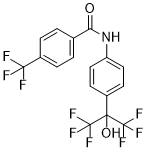SR-1078
This product is for research use only, not for human use. We do not sell to patients.

For small sizes, please check our retail website as below: www.invivochem.com
| Size | Price | Stock |
|---|---|---|
| 100mg | $800 | Check With Us |
| 250mg | $1350 | Check With Us |
| 500mg | $2025 | Check With Us |
Cat #: V15217 CAS #: 1246525-60-9 Purity ≥ 98%
Description: SR-1078 is a selective agonist of RORα and RORγ that stimulates ROR transcriptional activity in HEK293 cell reporter assays at concentrations as low as 2 µM without effect at the related liver X receptors and farnesoid X receptors.
Top Publications Citing Invivochem Products
Publications Citing InvivoChem Products
Product Promise

- Physicochemical and Storage Information
- Protocol
- Related Biological Data
- Stock Solution Preparation
- Quality Control Documentation
| Molecular Weight (MW) | 431.25 |
|---|---|
| Molecular Formula | C17H10F9NO2 |
| CAS No. | 1246525-60-9 |
| SMILES Code | O=C(NC1=CC=C(C(O)(C(F)(F)F)C(F)(F)F)C=C1)C2=CC=C(C(F)(F)F)C=C2 |
| Synonyms | SR-1078; SR 1078; SR1078 |
| Protocol | In Vitro | SR1078 is a synthetic RORα/RORγ ligand. SR1078 modulates the conformation of RORγ in a biochemical assay and activates RORα and RORγ driven transcription. Furthermore, SR1078 stimulates expression of endogenous ROR target genes in HepG2 cells that express both RORα and RORγ. In a cell-based chimeric receptor Gal4 DNA-binding domain-NR ligand binding domain cotransfection assay, SR1078 significantly inhibits the constitutive transactivation activity of RORα and RORγ, but has no effect on the activity of FXR, LXRα and LXRβ. In a RORα cotransfection assay, treatment of cells with SR1078 (10 μM) results in a significant increase in transcription. Similarly, in the RORγ cotransfection assay, SR1078 treatment results in a stimulation of RORγ-dependent transcription activit. |
|---|---|---|
| In Vivo | The pharmacokinetic properties of SR1078 are examined in mice and noted significant exposure. Plasma concentrations reach 3.6 μM 1h after a 10 mg/kg i.p. injection of SR1078 and sustained levels of above 800 nM even 8h after the single injection. These levels are sufficient to perform a proof-of-principle experiment to determine if SR1078 treatment would stimulate ROR target gene expression in an animal model. Mice are treated with SR1078 (10 mg/kg; i.p.) and 2h after the injection the livers are harvested and mRNA purified for assessment of G6Pase and FGF21 gene expression.T he expression of both FGF21 and G6Pase is significantly stimulated by SR1078 treatment vs. vehicle control. |
These protocols are for reference only. InvivoChem does not
independently validate these methods.
| Solvent volume to be added | Mass (the weight of a compound) | |||
|---|---|---|---|---|
| Mother liquor concentration | 1mg | 5mg | 10mg | 20mg |
| 1mM | 2.3188 mL | 11.5942 mL | 23.1884 mL | 46.3768 mL |
| 5mM | 0.4638 mL | 2.3188 mL | 4.6377 mL | 9.2754 mL |
| 10mM | 0.2319 mL | 1.1594 mL | 2.3188 mL | 4.6377 mL |
| 20mM | 0.1159 mL | 0.5797 mL | 1.1594 mL | 2.3188 mL |
The molarity calculator equation
Mass(g) = Concentration(mol/L) × Volume(L) × Molecular Weight(g/mol)
Mass
=
Concentration
×
Volume
×
Molecular Weight*
The dilution calculator equation
Concentration(start)
×
Volume(start)
=
Concentration(final)
×
Volume(final)
This equation is commonly abbreviated as: C1 V1 = C2 V2
Concentration(start)
C1
×
Volume(start)
V1
=
Concentration(final)
C2
×
Volume(final)
V2
Step One: Enter information below
Dosage mg/kg
Average weight of animals g
Dosing volume per animal µL
Number of animals
Step Two: Enter the in vivo formulation
%DMSO
+
%
+
%Tween 80
+
%ddH2O
Calculation Results:
Working concentration:
mg/ml;
Method for preparing DMSO master liquid:
mg
drug pre-dissolved in
µL
DMSO(Master liquid concentration
mg/mL)
,Please contact us first if the concentration exceeds the DMSO solubility of the batch of drug.
Method for preparing in vivo formulation:
Take
µL
DMSO master liquid, next add
µL
PEG300, mix and clarify, next add
µL
Tween 80,mix and clarify, next add
µL
ddH2O,mix and clarify.
Note:
- (1) Please be sure that the solution is clear before the addition of next solvent. Dissolution methods like vortex, ultrasound or warming and heat may be used to aid dissolving.
- (2) Be sure to add the solvent(s) in order.




































